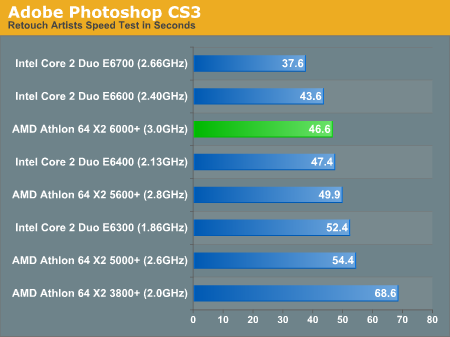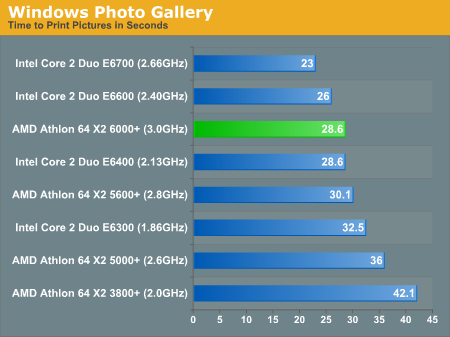AMD Athlon 64 X2 6000+: Competing with Aggressive Pricing
by Anand Lal Shimpi on February 20, 2007 3:37 PM EST- Posted in
- CPUs
Photo Processing Performance
We turned to the Retouch Artists Photoshop Speed Test for measuring CPU performance in Adobe's Photoshop CS3 beta. The benchmark applies a number of actions to a test image while we measure the total time elapsed during the active portion of the test. We report results in seconds, with lower scores denoting higher performance.
We set history states to 1 and cache levels to 4; CS3 was configured to make use of all available system memory.

Performance under Adobe Photoshop CS3 is not a strong point for the Athlon 64 X2 lineup as even the X2 6000+ can barely outperform the Core 2 Duo E6400. The rest of the model numbers fall around the speed of Intel's E6300 or slower. If you're a Photoshop user, AMD won't be able to do it for you.
Our next test is one recommended by Intel, but the test itself appears to be fair as it is a simple task using one of Vista's built in applications: Windows Photo Gallery. This test simply measures the amount of time required to print four sheets of thumbnails; of course we don't measure actual printing time, rather the benchmark exports the pictures to an Excel spreadsheet. Time is measured in seconds, with lower times resulting in better performance:

Although vastly different in usage pattern and purpose, the Windows Photo Gallery benchmark actually gave us results very similar to the CS3 benchmark. We suspect that the nature of these benchmarks tends to favor the notably faster SSE performance of the Core 2 processors, but if that's the case we may see the tables turn once AMD introduces Barcelona.
Finally we have a benchmark that was one of the first tests AMD sent around a while back to showcase what 64-bit processors could do for performance. The application is called the Panorama Factory and it is used to stitch together multiple digital pictures in order to make one larger picture, or a panorama. The stitching process can be quite CPU intensive so we used the benchmark to stitch together 10 6MP images of a room and reported the total process time:

Performance is pretty evenly split here between the two processor families. The E6700 is as fast as the X2 6000+, the E6600 and 5600+ are pretty close as are the E6400 and 5000+.










34 Comments
View All Comments
defter - Wednesday, February 21, 2007 - link
The maximum measured 8800GTX power consumption is about 150W. NVidia has mentioned that absolute maximum is 180W. However, since this is a CPU review, it's logical to assume that they stressed only the CPU in "full load" power consumption test.poohbear - Wednesday, February 21, 2007 - link
wow so 260w load plus 50w for a 8800gtx, thats only 310wts! kinda strange when companies are selling 1kilowatt psus.:/poohbear - Tuesday, February 20, 2007 - link
i was gonna ask the exact same question. I wish they'd clarify that in the articles when they talk about power consumption. Is that 263wts under load for the 5600+ JUST for the cpu or the whole system? thanks for any of the writers who can clarify this 100%.JarredWalton - Tuesday, February 20, 2007 - link
Power reports are always for the entire system. Obviously, lower end GPUs would reduce total power requirements quite a bit, but in maximum load testing the stress is only on the CPU and not the GPU. Thus, the ~50W power difference is going to remain whether you're running an 8800 GTX or an X1300 SE. The latter would simply use probably 40-50W less total power.bamacre - Tuesday, February 20, 2007 - link
Add in OC'ing and Intel, still, jumps further in the lead.BladeVenom - Tuesday, February 20, 2007 - link
But most people don't overclock.ViRGE - Tuesday, February 20, 2007 - link
Many of the readers of this site do though. The C2D is so mind numbingly easy to overclock, it's hard to not do it.Roy2001 - Tuesday, February 20, 2007 - link
I agree. I never OCed before. But with E6400 it is so easy. I just changed FSB from 266 to 350, I have a 2.8Ghz C2D. No voltage change, no cooling change. That's easy.mino - Tuesday, February 20, 2007 - link
Not to mention 800FSB E4300 parts.2.66/333FSB is pretty much a safe bet on most boards.
Even 2.13 for $150 is nice with board at STOCK FSB!.
Who needs E6400 then :) (for stock performance).
poohbear - Tuesday, February 20, 2007 - link
well if a 2.4ghz C2D can beat a AMD64 @ 3.0ghz, then calling a C2D @ 3.2ghz (the average overclock from what im reading) the "king" processor is a monumental understatement. It'd rape the 6000+.